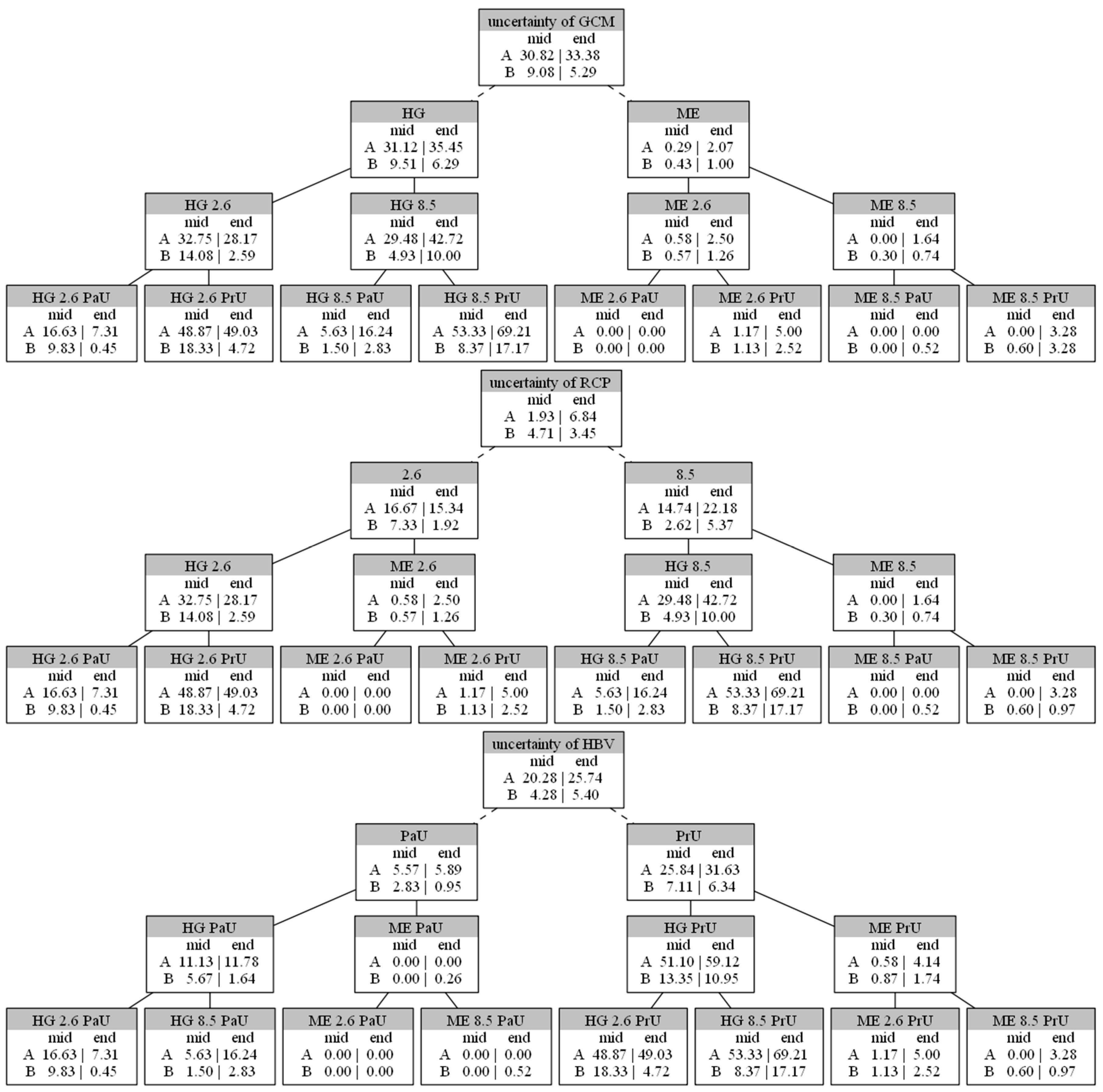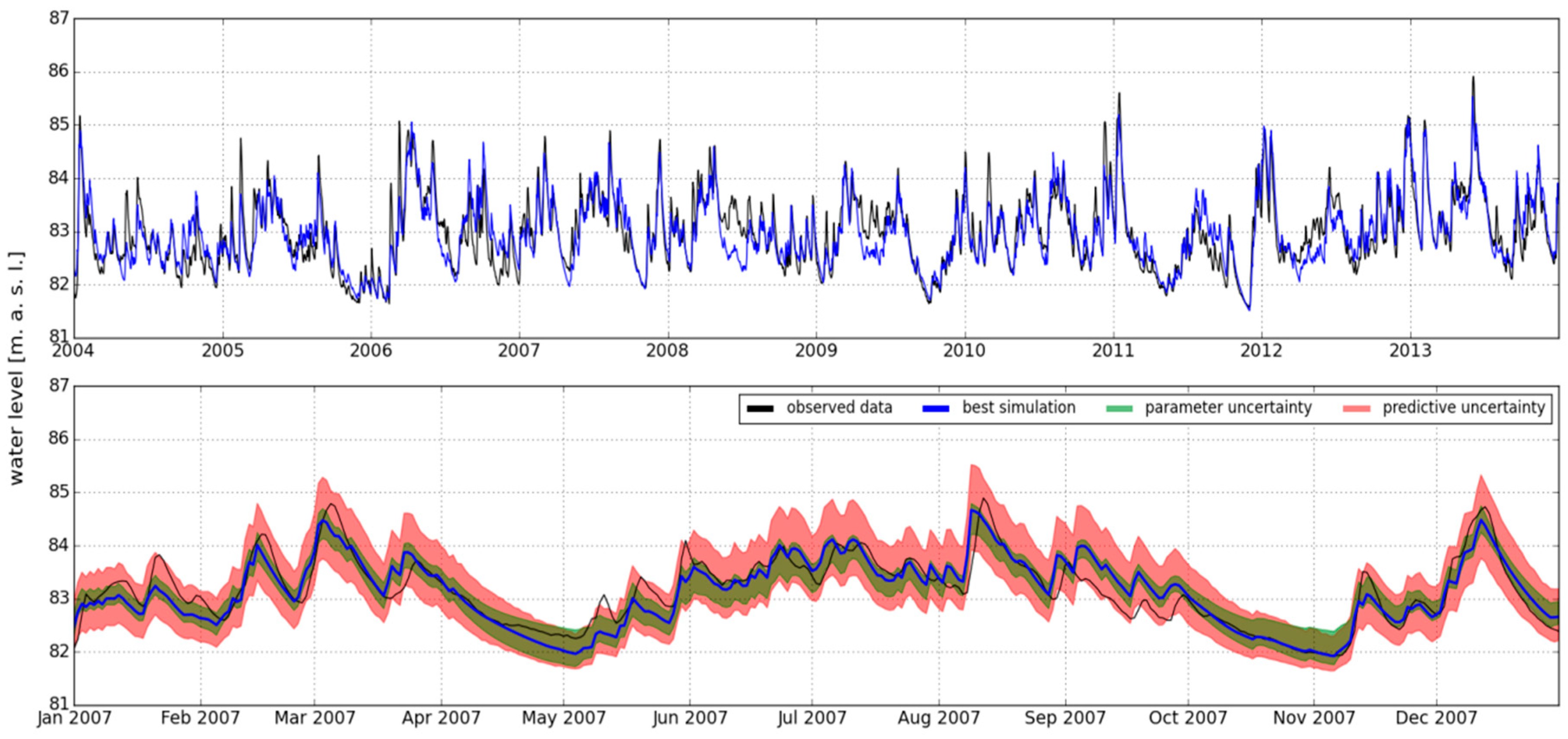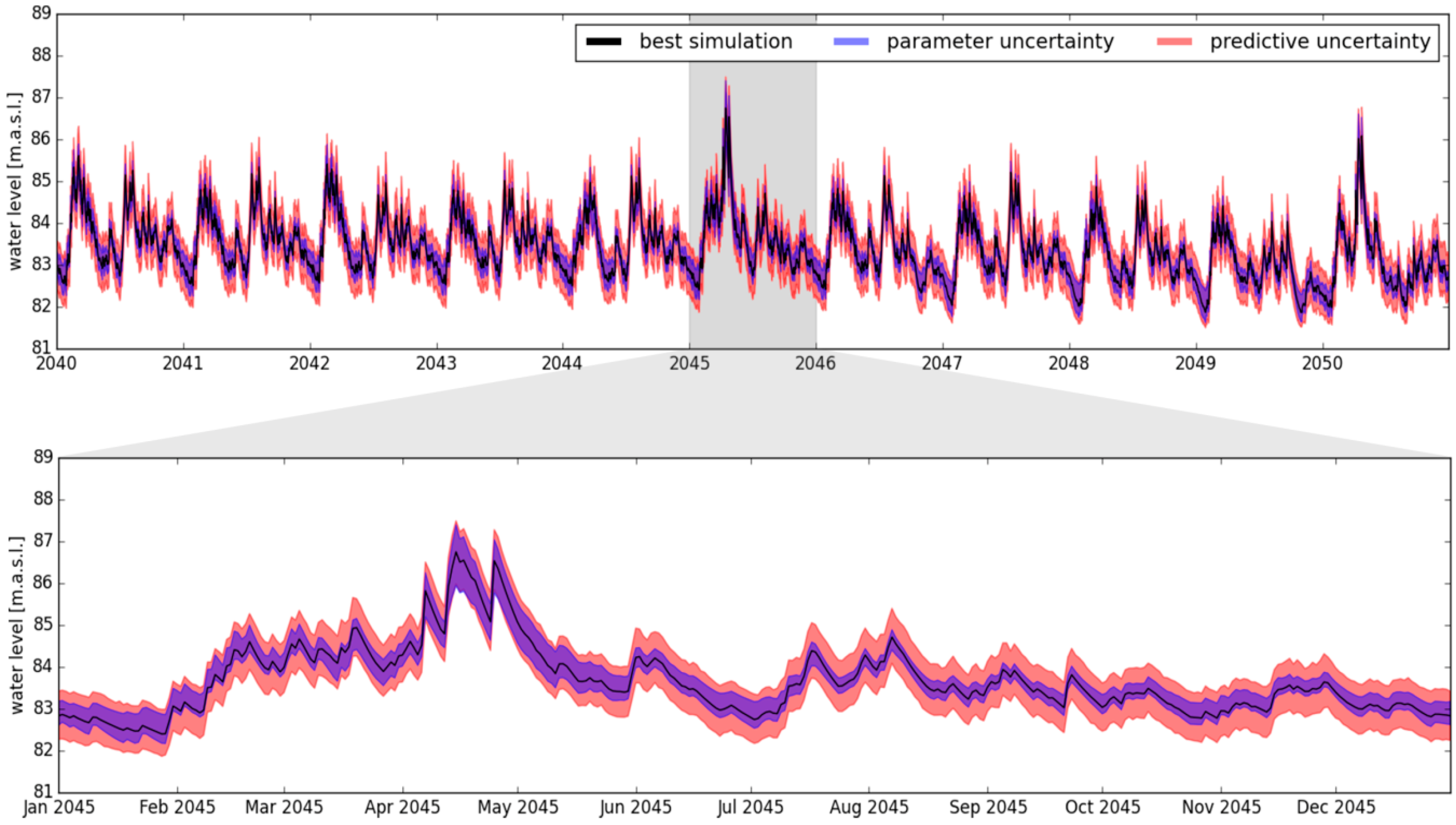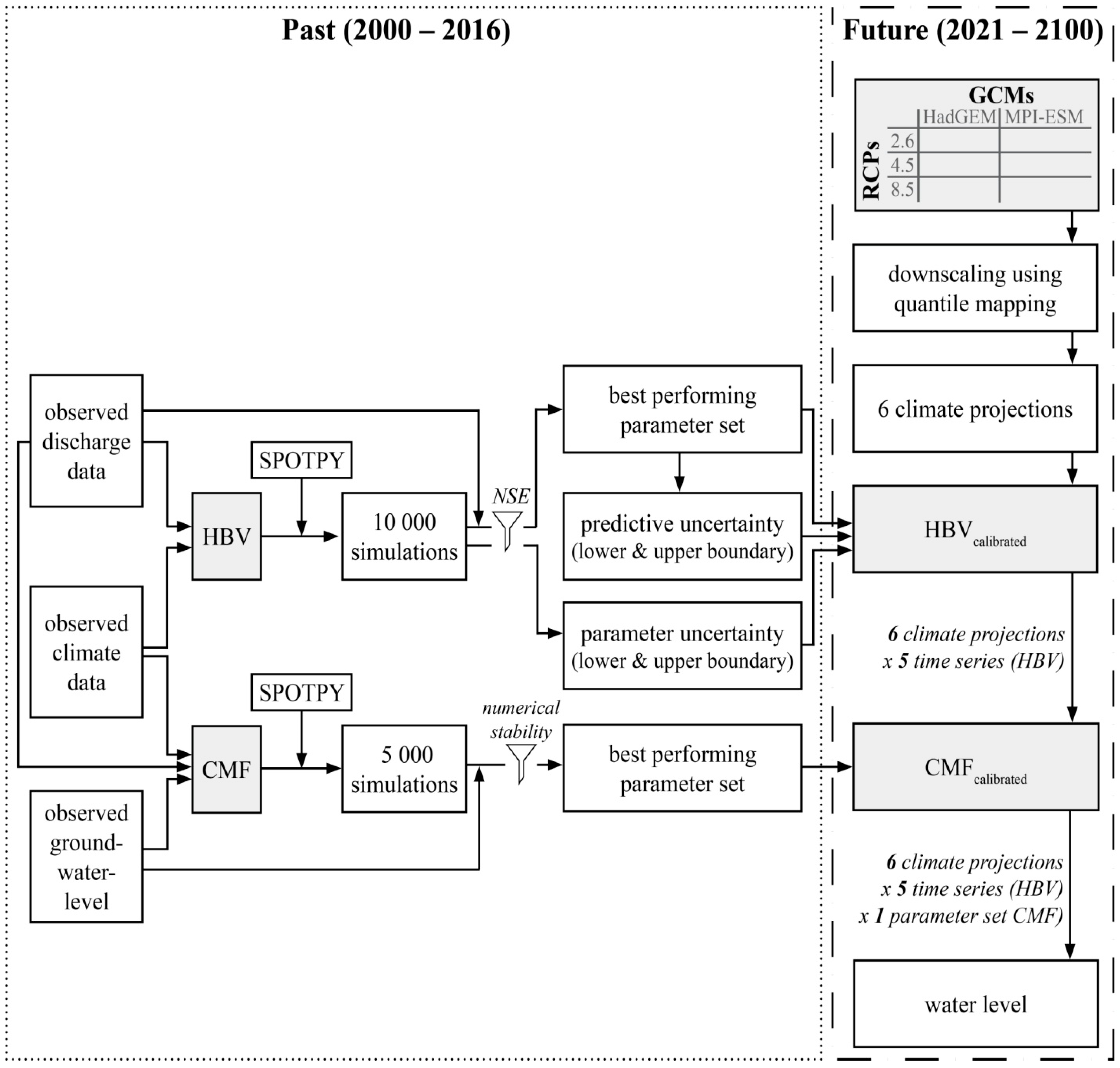Multi-Source Uncertainty Analysis in Simulating Floodplain Inundation under Climate Change
Abstract
:1. Introduction
2. Materials and Methods
2.1. Study Site
2.2. Surface Water–Groundwater Model
2.3. Water Level Forcing
2.4. Climate Forcing
3. Results
3.1. Projection of the Rhine River Water Level
3.2. Projection of Spatial Inundation
3.3. Uncertainty of Projections
4. Discussion
5. Conclusions
Author Contributions
Funding
Acknowledgments
Conflicts of Interest
Appendix A

| Parameter | Description | Unit | Lower Bound–Upper Bound | Best Parameter Set |
|---|---|---|---|---|
| CE | Potential Evapotranspiration model parameter | - | 0.01–0.2 | 0.09 |
| Theta | Actual evapotranspiration coefficient | - | 0.8–1.5 | 1.00 |
| TT | Threshold melting Temperature | °C | −0.98–2 | 0.43 |
| Cmelt | Sow melting parameter | - | 0.2–2.0 | 1.10 |
| FC | Field capacity | mm | 40–250 | 207.56 |
| Beta | Model parameter | - | 1–5 | 1.00 |
| PWP | Permanent wilting point | mm | 40–250 | 159.82 |
| L | Depth of upper reservoir | mm | 1–100 | 41.50 |
| K1 | Surface flow storage constant | 1/d | 10–800 | 25.27 |
| K2 | Interflow storage constant | 1/d | 10–850 | 35.85 |
| KZ | Percolation storage constant | 1/d | 10–980 | 178.53 |
| K3 | Baseflow storage constant | 1/d | 10–1000 | 353.30 |


| GCM | Winter | Spring | Summer | Autumn | ||
|---|---|---|---|---|---|---|
| 2000–2005 | observed | 171.50 mm | 183.88 mm | 197.35 mm | 196.72 mm | |
| HadGEM | historical | −8.53% ↙ | −0.17% ↙ | −11.75% ↙ | −0.27% ↙ | |
| MPI-ESM | MPI-ESM | −19.80% ↙ | −5.06% ↙ | −3.95% ↙ | 0.06% ↗ | |
| 2021–2050 | HadGem | RCP 2.6 | 14.73% ↗ | −0.05% ↙ | −11.42% ↙ | 17.87% ↗ |
| RCP 4.5 | 41.21% ↑ | 4.62% ↗ | −3.77% ↙ | 24.09% ↑ | ||
| RCP 8.5 | 24.36% ↗ | 7.29% ↗ | −9.52% ↙ | 30.91% ↑ | ||
| MPI | RCP 2.6 | 49.65% ↑ | 28.51% ↑ | −7.62% ↙ | 5.53% ↗ | |
| RCP 4.5 | 48.44% ↑ | 33.52% ↑ | −8.87% ↙ | −4.52% ↙ | ||
| RCP 8.5 | 41.14% ↑ | 19.12% ↗ | −15.60% ↙ | 1.64% ↗ | ||
| 2021–2050 | HadGem | RCP 2.6 | 34.57% ↑ | 6.55% ↗ | 3.68% ↑ | 15.00% ↗ |
| RCP 4.5 | 32.23% ↑ | −5.90% ↙ | −17.52% ↓ | 35.25% ↑ | ||
| RCP 8.5 | 55.99% ↑ | 2.30% ↗ | −39.73% ↓ | 28.44% ↑ | ||
| MPI | RCP 2.6 | 50.70% ↑ | 17.54% ↗ | −12.67% ↙ | 0.37% ↗ | |
| RCP 4.5 | 46.24% ↑ | 23.80% ↗ | −23.67% ↓ | −13.05% ↙ | ||
| RCP 8.5 | 51.50% ↑ | 24.30% ↗ | −43.64% ↓ | −8.56% ↙ |
| GCM | Winter | Spring | Summer | Autumn | ||
|---|---|---|---|---|---|---|
| 2000–2005 | observed | 83.12 m | 83.34 m | 82.99 m | 82.76 m | |
| HadGEM | historical | −0.31% ↓ | 0.27% ↗ | −0.05% ↙ | 0.11% ↗ | |
| MPI-ESM | MPI-ESM | −0.19% ↓ | −0.13% ↙ | 0.04% ↗ | 0.32% ↗ | |
| 2021–2050 | HadGem | RCP 2.6 | 0.68% ↑ | 0.30% ↗ | 1.22% ↑ | 1.21% ↑ |
| RCP 4.5 | 0.81% ↑ | 0.41% ↗ | 1.33% ↑ | 1.30% ↑ | ||
| RCP 8.5 | 0.66% ↑ | 0.29% ↗ | 1.21% ↑ | 1.21% ↑ | ||
| MPI | RCP 2.6 | 0.25% ↗ | 0.39% ↗ | 0.76% ↑ | 0.64% ↗ | |
| RCP 4.5 | 0.18% ↗ | 0.49% ↗ | 0.75% ↑ | 0.59% ↗ | ||
| RCP 8.5 | 0.11% ↗ | 0.35% ↗ | 0.74% ↑ | 0.54% ↗ | ||
| 2021–2050 | HadGem | RCP 2.6 | 0.64% ↑ | 0.26% ↗ | 1.22% ↑ | 1.18% ↑ |
| RCP 4.5 | 0.74% ↑ | 0.31% ↗ | 1.24% ↑ | 1.27% ↑ | ||
| RCP 8.5 | 0.72% ↑ | 0.25% ↗ | 1.20% ↑ | 1.19% ↑ | ||
| MPI | RCP 2.6 | 0.22% ↗ | 0.39% ↗ | 0.78% ↑ | 0.61% ↗ | |
| RCP 4.5 | 0.07% ↗ | 0.27% ↗ | 0.54% ↗ | 0.35% ↗ | ||
| RCP 8.5 | 0.02% ↗ | 0.28% ↗ | 0.17% ↗ | 0.08% ↗ |
References
- Hayashi, M.; Rosenberry, D.O. Effects of Ground Water Exchange on the Hydrology and Ecology of Surface Water. Ground Water 2002, 40, 309–316. [Google Scholar] [CrossRef] [PubMed]
- Maltby, E.; Barker, T. (Eds.) The Wetlands Handbook; Wiley-Blackwell: Oxford, UK, 2009; ISBN 978-1-4443-1581-3. [Google Scholar]
- Van Eck, W.H.J.M.; Van De Steeg, H.M.; Blom, C.W.P.M.; De Kroon, H. Is tolerance to summer flooding correlated with distribution patterns in river floodplains? A comparative study of 20 terrestrial grassland species. Oikos 2004, 107, 393–405. [Google Scholar] [CrossRef]
- Woodcock, B.A.; Mann, D.J.; Mirieless, C.; McGavin, G.C.; McDonald, A.W. Re-creation of a lowland flood-plain meadow. J. Insect Conserv. 2005, 9, 207–218. [Google Scholar] [CrossRef]
- Krause, S.; Bronstert, A.; Zehe, E. Groundwater-surface water interactions in a North German lowland floodplain—Implications for the river discharge dynamics and riparian water balance. J. Hydrol. 2007, 347, 404–417. [Google Scholar] [CrossRef]
- Taylor, R.G.; Scanlon, B.; Döll, P.; Rodell, M.; van Beek, R.; Wada, Y.; Longuevergne, L.; Leblanc, M.; Famiglietti, J.S.; Edmunds, M.; et al. Ground water and climate change. Nat. Clim. Chang. 2012, 3, 322–329. [Google Scholar] [CrossRef] [Green Version]
- Van Roosmalen, L.; Christensen, B.S.B.; Sonnenborg, T.O. Regional Differences in Climate Change Impacts on Groundwater and Stream Discharge in Denmark. Vadose Zone J. 2007, 6, 554–571. [Google Scholar] [CrossRef]
- Tockner, K.; Stanford, J.A. Riverine flood plains: Present state and future trends. Environ. Conserv. 2002, 29, 308–330. [Google Scholar] [CrossRef]
- Opperman, J.J.; Luster, R.; McKenney, B.A.; Roberts, M.; Meadows, A.W. Ecologically Functional Floodplains: Connectivity, Flow Regime, and Scale. J. Am. Water Resour. Assoc. 2010, 46, 211–226. [Google Scholar] [CrossRef]
- Capon, S.J.; Chambers, L.E.; Nally, R.M.; Naiman, R.J.; Davies, P.; Marshall, N.; Pittock, J.; Reid, M.; Capon, T.; Douglas, M.; et al. Riparian Ecosystems in the 21st Century: Hotspots for Climate Change Adaptation? Ecosystems 2013, 16, 359–381. [Google Scholar] [CrossRef]
- Demirel, M.C.; Booij, M.J.; Hoekstra, A.Y. Impacts of climate change on the seasonality of low flows in 134 catchments in the River Rhine basin using an ensemble of bias-corrected regional climate simulations. Hydrol. Earth Syst. Sci. 2013, 17, 4241–4257. [Google Scholar] [CrossRef] [Green Version]
- Dokulil, M. Impact of climate warming on European inland waters. Inland Waters 2014, 4, 27–40. [Google Scholar] [CrossRef]
- Middelkoop, H.; Daamen, K.; Gellens, D.; Grabs, W.; Kwadijk, J.C.; Lang, H.; Parmet, B.W.; Schädler, B.; Schulla, J.; Wilke, K. Impact of climate change on hydrological regimes and water resources management in the Rhine basin. Clim. Chang. 2001, 49, 105–128. [Google Scholar] [CrossRef]
- Herron, N.; Davis, R.; Jones, R. The effects of large-scale afforestation and climate change on water allocation in the Macquarie River catchment, NSW, Australia. J. Environ. Manag. 2002, 65, 369–381. [Google Scholar] [CrossRef]
- Mortsch, L.D. Assessing the impact of climate change on the Great Lakes shoreline wetlands. Clim. Chang. 1998, 40, 391–416. [Google Scholar] [CrossRef]
- Sorenson, L.G.; Goldberg, R.; Root, T.L.; Anderson, M.G. Potential Effects of Global Warming on Waterfowl Populations Breeding in the Northern Great Plains. Clim. Chang. 1998, 40, 343–369. [Google Scholar] [CrossRef]
- Thompson, J.R.; Gavin, H.; Refsgaard, A.; Refstrup Sørenson, H.; Gowing, D.J. Modelling the hydrological impacts of climate change on UK lowland wet grassland. Wetlands Ecol. Manag. 2009, 17, 503–523. [Google Scholar] [CrossRef]
- Opperman, J.J.; Galloway, G.E.; Fargione, J.; Mount, J.F.; Richter, B.D.; Secchi, S. Sustainable floodplains through large-scale reconnection to rivers. Science 2009, 326, 1487–1488. [Google Scholar] [CrossRef] [PubMed]
- Furman, A. Modeling Coupled Surface–Subsurface Flow Processes. Vadose Zone J. 2008, 7, 741. [Google Scholar] [CrossRef]
- Refsgaard, J.C.; Sørensen, H.R.; Mucha, I.; Rodak, D.; Hlavaty, Z.; Bansky, L.; Klucovska, J.; Topolska, J.; Takac, J.; Kosc, V.; et al. An Integrated Model for the Danubian Lowland—Methodology and Applications. Water Resour. Manag. 1998, 12, 433–465. [Google Scholar] [CrossRef]
- Alaghmand, S.; Beecham, S.; Woods, J.A.; Holland, K.L.; Jolly, I.D.; Hassanli, A.; Nouri, H. Quantifying the impacts of artificial flooding as a salt interception measure on a river-floodplain interaction in a semi-arid saline floodplain. Environ. Model. Softw. 2016, 79, 167–183. [Google Scholar] [CrossRef]
- House, A.R.; Thompson, J.R.; Acreman, M.C. Projecting impacts of climate change on hydrological conditions and biotic responses in a chalk valley riparian wetland. J. Hydrol. 2016, 534, 178–192. [Google Scholar] [CrossRef]
- Karim, F.; Petheram, C.; Marvanek, S.; Ticehurst, C.; Wallace, J.; Hasan, M. Impact of climate change on floodplain inundation and hydrological connectivity between wetlands and rivers in a tropical river catchment. Hydrol. Process. 2016, 30, 1574–1593. [Google Scholar] [CrossRef]
- Bredehoeft, J. The conceptualization model problem? Hydrogeol. J. 2005, 13, 37–46. [Google Scholar] [CrossRef]
- Kay, A.L.; Davies, H.N.; Bell, V.A.; Jones, R.G. Comparison of uncertainty sources for climate change impacts. Clim. Chang. 2009, 92, 41–63. [Google Scholar] [CrossRef] [Green Version]
- Refsgaard, J.C.; van der Sluijs, J.P.; Brown, J.; van der Keur, P. A framework for dealing with uncertainty due to model structure error. Adv. Water Resour. 2006, 29, 1586–1597. [Google Scholar] [CrossRef] [Green Version]
- Teng, J.; Vaze, J.; Chiew, F.H.S.; Wang, B.; Perraud, J.-M. Estimating the Relative Uncertainties Sourced from GCMs and Hydrological Models in Modeling Climate Change Impact on Runoff. J. Hydrometeorol. 2012, 13, 122–139. [Google Scholar] [CrossRef]
- Wilby, R.L. Uncertainty in water resource model parameters used for climate change impact assessment. Hydrol. Processes 2005, 19, 3201–3219. [Google Scholar] [CrossRef]
- Wilby, R.L.; Whitehead, P.G.; Wade, A.J.; Butterfield, D.; Davis, R.J.; Watts, G. Integrated modelling of climate change impacts on water resources and quality in a lowland catchment. J. Hydrol. 2006, 330, 204–220. [Google Scholar] [CrossRef]
- McMillan, H.K.; Brasington, J. End-to-end flood risk assessment. Water Resour. Res. 2008, 44, 295. [Google Scholar] [CrossRef]
- Pappenberger, F.; Beven, K.J.; Hunter, N.M.; Bates, P.D.; Gouweleeuw, B.T.; Thielen, J.; Roo, A.P.J. Cascading model uncertainty from medium range weather forecasts (10 days) through a rainfall-runoff model to flood inundation predictions within the European Flood Forecasting System (EFFS). Hydrol. Earth Syst. Sci. 2005, 9, 381–393. [Google Scholar] [CrossRef] [Green Version]
- Sorribas, M.V.; Paiva, R.C.D.; Melack, J.M.; Bravo, J.M.; Jones, C.; Carvalho, L.; Beighley, E.; Forsberg, B.; Costa, M.H. Projections of climate change effects on discharge and inundation in the Amazon basin. Clim. Chang. 2016, 136, 555–570. [Google Scholar] [CrossRef]
- Barron, O.; Silberstein, R.; Ali, R.; Donohue, R.; McFarlane, D.J.; Davies, P.; Hodgson, G.; Smart, N.; Donn, M. Climate change effects on water-dependent ecosystems in south-western Australia. J. Hydrol. 2012, 434–435, 95–109. [Google Scholar] [CrossRef]
- Maier, N.; Breuer, L.; Kraft, P. Prediction and uncertainty analysis of a parsimonious floodplain surface water–groundwater interaction model. Water Resour. Res. 2017. [Google Scholar] [CrossRef]
- Kraft, P.; Vaché, K.B.; Frede, H.-G.; Breuer, L. CMF: A Hydrological Programming Language Extension For Integrated Catchment Models. Environ. Model. Softw. 2011, 26, 828–830. [Google Scholar] [CrossRef]
- Kraft, P. cmf-Catchment Modelling Framework. Available online: http://fb09-pasig.umwelt.uni-giessen.de/cmf (accessed on 18 June 2018).
- Qu, Y.; Duffy, C.J. A semidiscrete finite volume formulation for multiprocess watershed simulation. Water Resour. Res. 2007, 43. [Google Scholar] [CrossRef] [Green Version]
- Allen, R.G.; Pereira, L.S.; Raes, D.; Smith, M. Crop Evapotranspiration; FAO Irrigation and Drainage Paper; FAO: Rome, Italy, 1998; Volume 56, ISBN 92-5-104219-5. [Google Scholar]
- Bergström, S. The HBV model. In Computer Models of Watershed Hydrology; Singh, V.P., Ed.; Water Resources Publications: Highlands Ranch, CO, USA, 1995; pp. 443–476. ISBN 978-0-918334-91-6. [Google Scholar]
- Lindström, G.; Johansson, B.; Persson, M.; Gardelin, M.; Bergström, S. Development and test of the distributed HBV-96 hydrological model. J. Hydrol. 1997, 201, 272–288. [Google Scholar] [CrossRef]
- Bárdossy, A.; Singh, S.K. Robust estimation of hydrological model parameters. Hydrol. Earth Syst. Sci. 2008, 12, 1273–1283. [Google Scholar] [CrossRef] [Green Version]
- Huang, S.; Kumar, R.; Flörke, M.; Yang, T.; Hundecha, Y.; Kraft, P.; Gao, C.; Gelfan, A.; Liersch, S.; Lobanova, A.; et al. Evaluation of an ensemble of regional hydrological models in 12 large-scale river basins worldwide. Clim. Chang. 2017, 141, 381–397. [Google Scholar] [CrossRef]
- Te Linde, A.H.; Aerts, J.C.J.H.; Hurkmans, R.T.W.L.; Eberle, M. Comparing model performance of two rainfall-runoff models in the Rhine basin using different atmospheric forcing data sets. Hydrol. Earth Syst. Sci. 2008, 12, 943–957. [Google Scholar] [CrossRef] [Green Version]
- Vetter, T.; Huang, S.; Aich, V.; Yang, T.; Wang, X.; Krysanova, V.; Hattermann, F. Multi-model climate impact assessment and intercomparison for three large-scale river basins on three continents. Earth Syst. Dyn. 2015, 6, 17–43. [Google Scholar] [CrossRef] [Green Version]
- Beven, K.; Binley, A. The future of distributed models: Model calibration and uncertainty prediction. Hydrol. Processes 1992, 6, 279–298. [Google Scholar] [CrossRef]
- Houska, T.; Kraft, P.; Chamorro-Chavez, A.; Breuer, L. SPOTting Model Parameters Using a Ready-Made Python Package. PLoS ONE 2015, 10, e0145180. [Google Scholar] [CrossRef] [PubMed]
- Nash, J.E.; Sutcliffe, J.V. River flow forecasting through conceptual models part I—A discussion of principles. J. Hydrol. 1970, 10, 282–290. [Google Scholar] [CrossRef]
- McInerney, D.; Thyer, M.; Kavetski, D.; Lerat, J.; Kuczera, G. Improving probabilistic prediction of daily streamflow by identifying Pareto optimal approaches for modeling heteroscedastic residual errors. Water Resour. Res. 2017, 53, 2199–2239. [Google Scholar] [CrossRef]
- Box, G.E.P.; Cox, D.R. An Analysis of Transformations-Revisited. J. Am. Statist. Assoc. 1982, 77, 177–182. [Google Scholar] [CrossRef]
- Taylor, K.E.; Stouffer, R.J.; Meehl, G.A. An Overview of CMIP5 and the Experiment Design. Bull. Am. Meteorol. Soc. 2012, 93, 485–498. [Google Scholar] [CrossRef] [Green Version]
- McSweeney, C.F.; Jones, R.G.; Lee, R.W.; Rowell, D.P. Selecting CMIP5 GCMs for downscaling over multiple regions. Clim. Dyn. 2015, 44, 3237–3260. [Google Scholar] [CrossRef]
- Brands, S.; Herrera, S.; Fernández, J.; Gutiérrez, J.M. How well do CMIP5 Earth System Models simulate present climate conditions in Europe and Africa? Clim. Dyn. 2013, 41, 803–817. [Google Scholar] [CrossRef] [Green Version]
- Keuler, K.; Radtke, K.; Kotlarski, S.; Lüthi, D. Regional climate change over Europe in COSMO-CLM: Influence of emission scenario and driving global model. Meteorol. Z. 2016, 25, 121–136. [Google Scholar] [CrossRef]
- Zubler, E.M.; Fischer, A.M.; Fröb, F.; Liniger, M.A. Climate change signals of CMIP5 general circulation models over the Alps—Impact of model selection. Int. J. Climatol. 2016, 36, 3088–3104. [Google Scholar] [CrossRef]
- Maraun, D.; Wetterhall, F.; Ireson, A.M.; Chandler, R.E.; Kendon, E.J.; Widmann, M.; Brienen, S.; Rust, H.W.; Sauter, T.; Themeßl, M.; et al. Precipitation downscaling under climate change. Rev. Geophys. 2010, 48, 219. [Google Scholar] [CrossRef]
- Themeßl, M.J.; Gobiet, A.; Leuprecht, A. Empirical-statistical downscaling and error correction of daily precipitation from regional climate models. Int. J. Climatol. 2011, 31, 1530–1544. [Google Scholar] [CrossRef]
- Prudhomme, C.; Davies, H. Assessing uncertainties in climate change impact analyses on the river flow regimes in the UK. Part 2. Clim. Chang. 2009, 93, 197–222. [Google Scholar] [CrossRef]
- Quintana Seguí, P.; Ribes, A.; Martin, E.; Habets, F.; Boé, J. Comparison of three downscaling methods in simulating the impact of climate change on the hydrology of Mediterranean basins. J. Hydrol. 2010, 383, 111–124. [Google Scholar] [CrossRef] [Green Version]
- Chen, J.; Brissette, F.P.; Chaumont, D.; Braun, M. Finding appropriate bias correction methods in downscaling precipitation for hydrologic impact studies over North America. Water Resour. Res. 2013, 49, 4187–4205. [Google Scholar] [CrossRef] [Green Version]
- Gudmundsson, L.; Bremnes, J.B.; Haugen, J.E.; Engen-Skaugen, T. Downscaling RCM precipitation to the station scale using statistical transformations—A comparison of methods. Hydrol. Earth Syst. Sci. 2012, 16, 3383–3390. [Google Scholar] [CrossRef]
- Teutschbein, C.; Seibert, J. Bias correction of regional climate model simulations for hydrological climate-change impact studies. J. Hydrol. 2012, 456–457, 12–29. [Google Scholar] [CrossRef]
- David, P.G. Changes in plant communities relative to hydrologic conditions in the Florida Everglades. Wetlands 1996, 16, 15–23. [Google Scholar] [CrossRef]
- Mathar, W.; Kleinebecker, T.; Hölzel, N.; Collins, B. Environmental variation as a key process of co-existence in flood-meadows. J. Veg. Sci. 2015, 26, 480–491. [Google Scholar] [CrossRef]
- Mockler, E.M.; Chun, K.P.; Sapriza-Azuri, G.; Bruen, M.; Wheater, H.S. Assessing the relative importance of parameter and forcing uncertainty and their interactions in conceptual hydrological model simulations. Adv. Water Resour. 2016, 97, 299–313. [Google Scholar] [CrossRef]
- Refsgaard, J.C.; Arnbjerg-Nielsen, K.; Drews, M.; Halsnæs, K.; Jeppesen, E.; Madsen, H.; Markandya, A.; Olesen, J.E.; Porter, J.R.; Christensen, J.H. The role of uncertainty in climate change adaptation strategies—A Danish water management example. Mitig. Adapt. Strateg. Glob. Chang. 2013, 18, 337–359. [Google Scholar] [CrossRef] [Green Version]
- Her, Y.; Yoo, S.-H.; Seong, C.; Jeong, J.; Cho, J.; Hwang, S. Comparison of uncertainty in multi-parameter and multi-model ensemble hydrologic analysis of climate change. Hydrol. Earth Syst. Sci. Discuss. 2016, 1–44. [Google Scholar] [CrossRef]
- Chen, J.; Brissette, F.P.; Poulin, A.; Leconte, R. Overall uncertainty study of the hydrological impacts of climate change for a Canadian watershed. Water Resour. Res. 2011, 47, 176. [Google Scholar] [CrossRef]
- Pechlivanidis, I.G.; Arheimer, B.; Donnelly, C.; Hundecha, Y.; Huang, S.; Aich, V.; Samaniego, L.; Eisner, S.; Shi, P. Analysis of hydrological extremes at different hydro-climatic regimes under present and future conditions. Clim. Chang. 2017, 141, 467–481. [Google Scholar] [CrossRef]
- Eamus, D.; Froend, R.; Loomes, R.; Hose, G.; Murray, B. A functional methodology for determining the groundwater regime needed to maintain the health of groundwater-dependent vegetation. Aust. J. Bot. 2006, 54, 97–114. [Google Scholar] [CrossRef]






| Time Period | Past | Mid-Century | End-Century | ||||||||||
|---|---|---|---|---|---|---|---|---|---|---|---|---|---|
| GCM model | HadGEM | MPI-ESM | HadGEM | MPI-ESM | |||||||||
| RCP | 2.6 | 4.5 | 8.5 | 2.6 | 4.5 | 8.5 | 2.6 | 4.5 | 8.5 | 2.6 | 4.5 | 8.5 | |
| Parameter uncertainty | 0.85 | 0.46 | 0.50 | 0.46 | 0.47 | 0.48 | 0.56 | 0.37 | 0.36 | 0.37 | 0.41 | 0.35 | 0.39 |
| Predictive uncertainty | 1.16 | 1.32 | 1.34 | 1.35 | 1.18 | 1.32 | 1.35 | 1.24 | 1.25 | 1.27 | 1.21 | 1.22 | 1.26 |
© 2018 by the authors. Licensee MDPI, Basel, Switzerland. This article is an open access article distributed under the terms and conditions of the Creative Commons Attribution (CC BY) license (http://creativecommons.org/licenses/by/4.0/).
Share and Cite
Maier, N.; Breuer, L.; Chamorro, A.; Kraft, P.; Houska, T. Multi-Source Uncertainty Analysis in Simulating Floodplain Inundation under Climate Change. Water 2018, 10, 809. https://doi.org/10.3390/w10060809
Maier N, Breuer L, Chamorro A, Kraft P, Houska T. Multi-Source Uncertainty Analysis in Simulating Floodplain Inundation under Climate Change. Water. 2018; 10(6):809. https://doi.org/10.3390/w10060809
Chicago/Turabian StyleMaier, Nadine, Lutz Breuer, Alejandro Chamorro, Philipp Kraft, and Tobias Houska. 2018. "Multi-Source Uncertainty Analysis in Simulating Floodplain Inundation under Climate Change" Water 10, no. 6: 809. https://doi.org/10.3390/w10060809
APA StyleMaier, N., Breuer, L., Chamorro, A., Kraft, P., & Houska, T. (2018). Multi-Source Uncertainty Analysis in Simulating Floodplain Inundation under Climate Change. Water, 10(6), 809. https://doi.org/10.3390/w10060809





